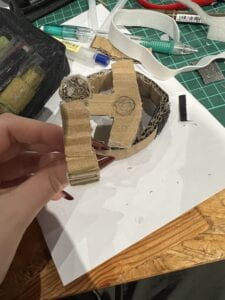Through this project, I came to understand the significance of designing products that cater to the needs of individuals with disabilities. Contrasting my experience with empathy tools to my previous encounters with everyday artifacts, showed me that I had not fully grasped the extent of limitations these commonly used products could pose for this demographic. Trying out an empathy tool created by another group for partial hearing, which resembled a headband with carbon tubes positioned at ear level to simulate hearing impediments, provided me with a profound experience. Wearing the tool induced feelings of disorientation and being overwhelmed. However, a notable distinction from my peers was my ability to still discern the direction from which sounds came.

Nevertheless, the comments shared by my group mates inspired me to develop my idea, GlowAlert. I believe that society often perceives individuals with disabilities as unable to lead independent lives, assuming they always require assistance. However, this workshop prompted me to question whether people with partial hearing truly need to rely on others or if it is a matter of the industry not creating and designing suitable products for their inclusion. During our brainstorming sessions, I reflected on situations involving high levels of noise. One scenario that stood out to me was driving, where individuals with partial hearing may struggle to detect when a car is honking at them.
GlowAlert is an attachable alarm designed to alert you when a car horn sounds near you or towards your direction. This device detects incoming honks and signals you by illuminating a gentle red bulb. Unlike intense flashlights that can be distracting and compromise safety while driving, GlowAlert’s alarm ensures a clear, non-intrusive alert for the user. For optimal effectiveness, it is recommend attaching it to your steering wheel, providing you with full visibility and ensuring efficient alerts for a safer driving experience.

During the prototyping process, I initially created the alert, which consisted of a small light bulb attached to a rectangular vertical base to enhance the alarm’s visibility. However, I realized that if the product were to stand alone as a prototype, its purpose and functionality might not be fully understood during the project swap with the other team.

Therefore, as the next step after receiving tester feedback, I incorporated a feature to encapsulate the functionality of GlowAlert. I created a base and a small steering wheel, both equipped with Velcro to simulate how they can be attached and allow for position adjustments based on user preference. To enhance the prototype’s visual representation, I utilized a red cloth piece to demonstrate the activation of the red light.

Finally our group created the presentation for our next project swap with the other teams, each one of us focused on their product, and detailed characteristics of what they aim to solve or ease. After that, us and the other team conducted a short informal presentation introducing each of our three products for the assigned impairment. The next step is to model the inventions made by the other group!
